October 11 - 17, 2015: Issue 235
Australian Predators of the Sky
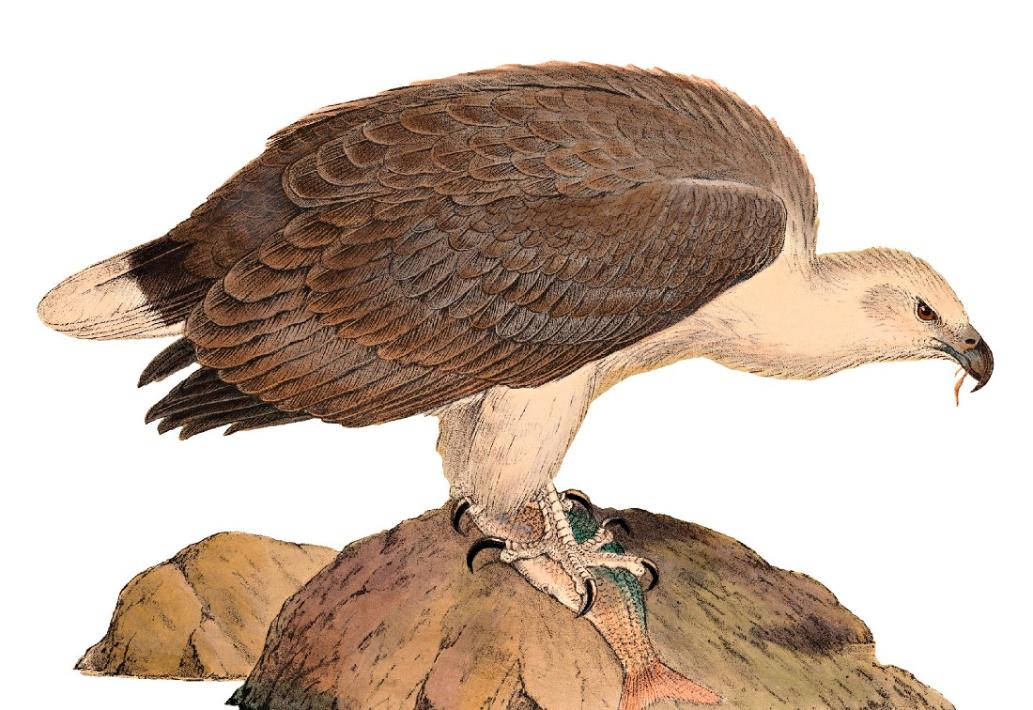
Henrik Grönvold (1858–1940) Haliaeëtus leucogaster (White-bellied Sea-eagle) between 1916 and 1917 page 59.
Australian Predators of the Sky
By Penny Olsen - Published by National Library of Australia
National Bird Week 2015 will take place between Monday 19 October and Sunday 25 October. The celebration of National Bird Week has its origins back in the early 1900s when the first 'bird days' were promoted by Birdlife Australia’s predecessor, the Royal Australasian Ornithologists Union. See: National Bird Week October 19-25 and the 2015 the Aussie Back Yard Bird Count: Australia's First Bird Counts - a 115 Year Legacy
This week we'd like to share another celebration to inspire all our local bird-lovers with an insight into a wonderful new book by one of Australia's foremost ornithologists on the subject of Australian raptors, Dr. Penny Olsen.
This work is also a celebration of the wonderful collection of bird records and bird art that forms part of our National Library of Australia and, as in previous books written by Dr. Olsen and published by the NLA, Australian Predators of the Sky illuminates an articulate mapping of our earliest observers of Australian raptors with beautiful imagery.
Australian Predators of the Sky comprises over 200 striking paintings, lithographs and engravings of all 34 Australian species—25 diurnal birds of prey and nine owls. For each species, a distribution map is provided, as well as the origins of its scientific name. Several full-colour illustrations of the species by various artists are accompanied by intriguing notes about the bird. For example, did you know that early settlers named the Nankeen Kestrel because it was the colour of a sturdy, brownish-yellow cotton cloth made in Nanking, China?
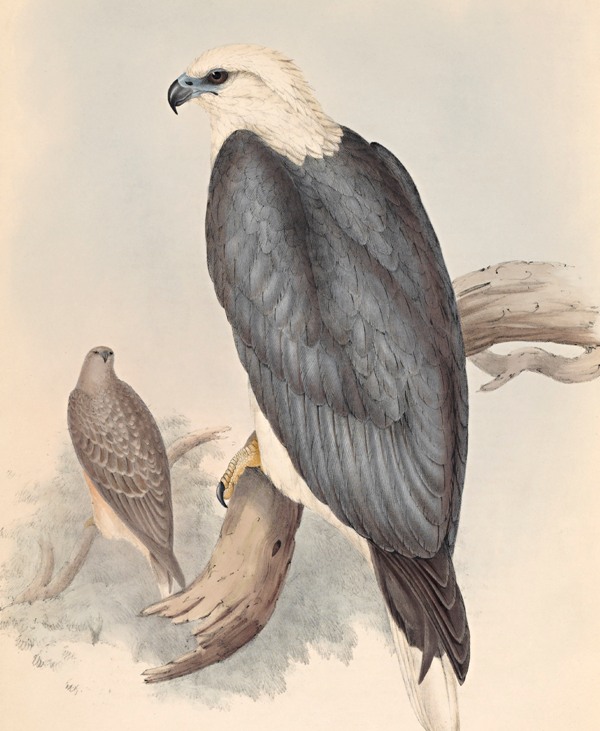
John Gould and Elizabeth Gould Ichthyiaëtus leucogaster (White-bellied Sea-eagle) 1848: Adult, in front; immature, behind - page 58
In Pittwater we are lucky to have both aquatic and land based raptors, we can see kites, sea eagles, ospreys, falcons, and owls of the Mopoke/Southern Boobook and Powerful kind as well as Tawny Frogmouths, a species of nightjar. With a copy of Australian Predators of the Sky you will be able to gain further insights into what you see during the day, and hear during the night hours.
From Dr. Olsen's NLA Blog Post on Australian Predators of the Sky:
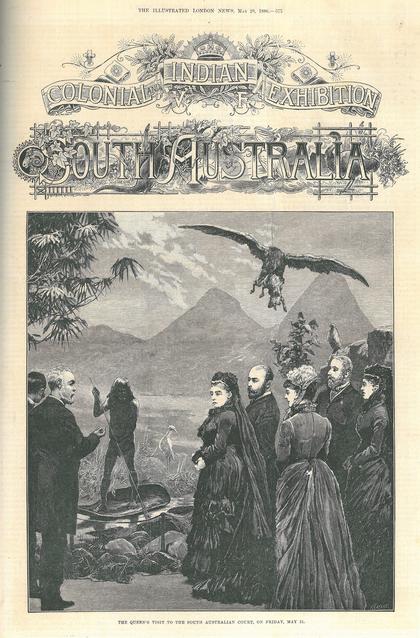 As often happens, too late and in researching an entirely different subject, I happened upon the perfect illustration for my new book, Australian Predators of the Sky. The image was titled ‘The Queen's Visit to the South Australian Court ...' and it made an attention-grabbing cover of the last issue of The Illustrated London News for May 1886. The accompanying text claimed that Queen Victoria was among the many who enjoyed ‘the realistic scene on the banks of the Murray River', created for the Colonial and Indian Exhibition, in London.
As often happens, too late and in researching an entirely different subject, I happened upon the perfect illustration for my new book, Australian Predators of the Sky. The image was titled ‘The Queen's Visit to the South Australian Court ...' and it made an attention-grabbing cover of the last issue of The Illustrated London News for May 1886. The accompanying text claimed that Queen Victoria was among the many who enjoyed ‘the realistic scene on the banks of the Murray River', created for the Colonial and Indian Exhibition, in London.
The diorama was set among displays of minerals, timber and the busts of explorers, and was festooned with taxidermied animals. Against a painted backdrop, parakeets cavort, pelicans catch fish and, as the accompanying text states, ‘an eagle has just snatched up a kangaroo kid, and is bearing off his prey to a nest of eager eaglets'.
In Predators, I pointed to the dichotomy of attitudes towards birds of prey: at once admired and reviled. The day-active raptors are admired for their powers of flight and sight, and reviled for their depredations on livestock or garden birds. Their nocturnal counterparts, the owls, are either wise or harbingers of death. We may no longer be superstitious about owls, but old prejudices against eagles, falcons and goshawks are alive and well in certain sectors. The rest of us are enthusiasts, for birds of prey are magnificent animals. They include the fastest animal on earth—the Peregrine Falcon—and some of the most effortless and highest of fliers. They are full of interest and come in great variety. Some of the owls can hunt in absolute darkness and one of the day-active birds of prey, the Letter-winged Kite, has become nocturnal. Some can see in the ultraviolet range, unavailable to humans. So, kestrels, for example, can detect the UV-visible urine trails of their rodent prey.
Returning to my newly discovered nineteenth-century woodcut, close inspection revealed that the eagle was making off not with a kangaroo, but a cloven-hooved animal and one of economic value—a sheep. In fact, the diorama showed the negative side, the demonisation of eagles; predators as an excuse for poor production: ‘the eagle/dingo/thylacine stole my lambs'.
Modern research shows that the Wedge-tailed Eagle rarely kills viable lambs, nor could an eagle carry a sheep. In life, the strung-up eagle would have had a body mass of only 3–4 kg. At weaning (3 months old), the weight of a Merino sheep is 20 kg. The feat, as depicted in the exhibit, is a physical impossibility! I like to think that is why Victoria is not looking particularly amused.
We spoke to Penny about her new celebration of Australian Predators of the Sky:
PON: Please share an example of one of the little known characteristics of any of these predators that people may not be aware of:
Dr.O: People are always surprised that a mighty Wedge-tailed Eagle, wingspan around 2 metres, weighs less than the average domestic cat, but can kill a dingo or a kangaroo.
PON: Our older newspapers and even those into the 1950's/1960's show ‘bird hunting' and especially 'Predator Bird Hunting' by farmers, was a common practice - laws had to be changed to prevent this and still species like the wedge-tailed eagle are now 'endangered' - what instances of societal attitudes did you find in your work that best epitomise this perception of a 'right to kill' by humans?
Dr.O: As I write in Predators, the word 'raptor' has the same derivation as ‘rapturous’ and 'rape'. The same dichotomy applies to how we feel about raptors. Even today, we generally either love or hate raptors: admire them for their majesty and amazing powers of flight and sight, or detest them because they kill lambs or garden birds. In the early days, even ornithologists wrote about 'useful birds' —the birds that eat insect pests or provide food for us. Raptors weren't on that list. Today we value and protect all of nature, so that it is an offence to wilfully kill a bird of prey or destroy its nests/eggs. Thankfully, only a very small minority disregard the laws. Most species are faring well, but a few like the Tasmanian Wedge-tailed Eagle - are endangered because of their rarity.
PON: This wonderful new book collates and celebrates some beautiful artworks by those first to encounter these birds and wonderful historically significant and contemporary Australian artists - what differences in style did you notice and did this detract from the accuracy of their art?
Dr.O: Several of the early artists of Australian birds of prey had never seen a live bird. They had to work from specimens sent back to England, often in a poor state of preservation. Generally, they drew them as they saw them, stuffed and attached to a sawn off branch. Later artists were expected to include an indication of behaviour and/or habitat and they had often grown up in Australia and understood our landscapes. Even then, some were simply more of an ornithologist than they were an artist. In the book, I tried to include examples from most of the significant players in the history of Australian ornithology. Even the quaint illustrations have a certain charm.
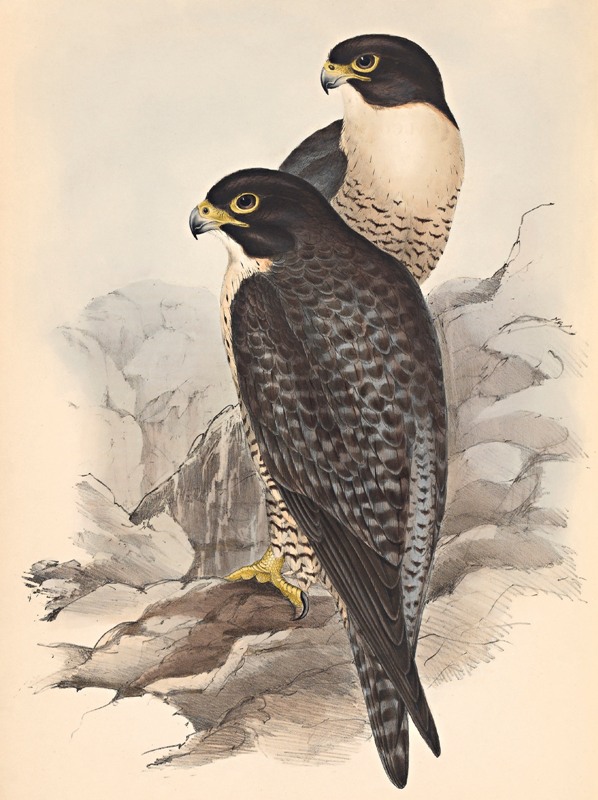
John Gould (artist) and Elizabeth Gould (lithographer) Falco melangenys (Black-cheeked Falcon) 1848 - from page 145
PON: Art again!: if you had to nominate a favourite from the paintings, lithographs and engravings of all 34 Australian species (25 diurnal birds of prey and 9 owls) shared in Australian Predators of the Sky - which would it be and why?
Dr.O: I don't have a favourite - truly! The works from Gould's books are generally the most faithful to the live bird, but I also enjoy some of the very early quirky works. Others have appeal because of their history....
PON: A focus on Raptors is a bit of a return home for you to subject matter and Natural History you have a wonderful insight on - what attracted you to this work?
Dr.O: Raptors are my favourite birds and, as you suggest, I spent most of my career as a biologist chasing them in the field every spring-summer. In fact, I think all predators are endlessly interesting. Early in my career, my research subjects were marsupial mice and then water rats, both predators.
Australian Predators of the Sky
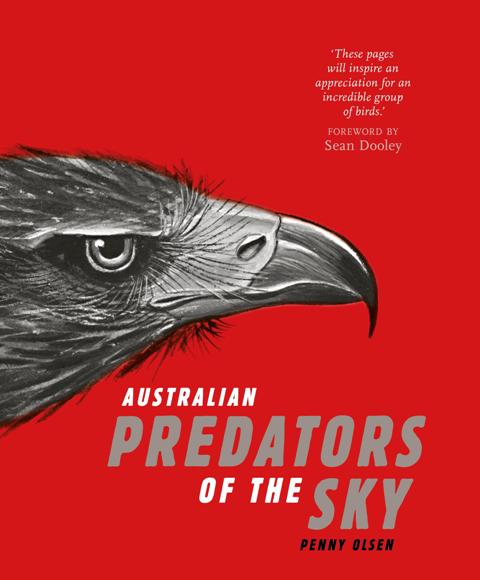 Author: Penny Olsen
Author: Penny Olsen
Publisher: Purchase online at National Library of Australia
Edition: 1st Edition. Pages: 216
Publication Date: 01 September 2015. Price $39.99
Our relationship with the birds of prey has always been conflicted. Raptors are admired for their strength and independence, but despised for their depredations on livestock and favourite garden birds, while the owls are at once respected for their wisdom and watchfulness and feared for their mournful cries and association with darkness and ill-omen.
The book begins with a fascinating chapter on the European discovery of birds of prey in Australia—for example, the earliest sightings of eagles by William Dampier’s expedition in 1699 in south-western Australia and Captain James Cook’s reports of kites, hawks, eagles and owls at Endeavour Bay in Queensland in 1770; the naming and describing of species in the nineteenth century; and John Gould’s visit to Australia to describe and illustrate its birds, including the birds of prey which filled the first of the seven volumes his The Birds of Australia in the 1840s. Another chapter describes the physical characteristics of birds of prey, their distribution, their hunting methods and other ecological features.
For each species, a distribution map is provided, as well as the origins of its scientific name. Several full-colour illustrations of the species by various artists are accompanied by intriguing notes about the bird. For example:
• The Black-breasted Buzzard uses a stone to smash eggs of ground-nesting birds.
• Early settlers named the Nankeen Kestrel because it was the colour of a sturdy, brownish-yellow cotton cloth made in Nanking, China.
• The Black Kite uses bait to lure in fish and crustaceans and has learned to flip Cane Toads into their backs to avoid their poison glands.
• The Australian Hobby (a falcon) inhabits a vacated nest of a crow instead of building its own.
• The Peregrine Falcon can reach speeds of 322 km/hr when diving after prey in the air.
• The Barking Owl, with its shrill, woman-like sobbing scream, is the possible source of the myths of the bunyip, a creature that inhabited swamps and ate women.
• The long-legged Eastern Grass Owl roosts and nests on the ground and has a nest with an approach run.
Australian Predators of the Sky comprises over 200 striking paintings, lithographs and engravings of all 34 Australian species—25 diurnal birds of prey and nine owls. From odd-looking first depictions to stunning, detailed portrayals of the species, the illustrations cover more than two centuries of bird art, selected from the National Library of Australia’s collection. The artists include George Raper and John Hunter (First Fleet naval officers), Sarah Stone, John and Elizabeth Gould, Henry Constantine Richter, Henrik Grönvold, Ellis Rowan, Neville Henry Cayley, Lionel Lindsay, Lilian Medland, Ebenezer Edward Gostelow, and, more recently, Betty Temple Watts, Frank Knight and Jeff Davies.
______________________________________________
Dr Penny Olsen is an ornithologist, researcher and writer with a passion for natural history. She completed her first science degree at the Australian National University in 1969 and worked as an Experimental Officer with the CSIRO. After taking time off to raise her children, she took on the role of President of the Australasian Raptor Association from 1984 to 1989. She went back to university to do a PhD on the breeding ecology of raptors, which she completed in 1991. Her distinguished career earned her the 1997 D.L. Serventy Medal for services to ornithology presented by the Royal Australasian Ornithologists Union. In 2011 she was made a Member of the Order of Australia 'for service to the conservation sciences as an author and researcher, and through the study and documentation of Australian bird species and their history'. She is currently an Associate Professor in the Research School of Biology at the Australian National University. She learnt in late 2013 that she was to be given special commendation from the Royal Zoological Society of New South Wales for her body of work.
Based on her research as a Harold White Fellow, Penny published Glimpses of Paradise: The Quest for the Beautiful Parrakeet through the National Library in 2007, and has since been one of our most prolific authors. She is a frequent contributor to the Library magazine and has written a number of books, including books for children, based on the Library’s extensive collections of material relating to Australian birds and animals.
NLA Publications:
General:
Upside Down World: Early European Impressions of Australia’s Curious Animals
Glimpses of Paradise: The Quest for the Beautiful Parrakeet (2008 Whitley Award from The Royal Zoological Society of New South Wales for Historical Zoology—Winner)
Collecting Ladies: Ferdinand von Mueller and Women Botanical Illustrators
A Brush with Birds: Australian Bird Art from the National Library of Australia (2009 Australian Book Industry Awards Illustrated Book of the Year—Shortlisted)
A Botanical Life: Robert David Fitzgerald
A Flutter of Butterflies (with Michael Braby)
Cayley & Son: The Life and Art of Neville Henry Cayley & Neville William Cayley (2013 Whitley Award for best book in the category Historical Zoology)
An Eye for Nature: The Life and Art of William T. Cooper
Louisa Atkinson's Nature Notes
Australian Predators of the Sky
Children:
Our Nest Is Best! (with Penny O'Hara)
The Best Nest
Have You Seen My Egg? (illustrated by Rhonda N. Garward)
Blog Posts:
Cayley & Son blog post
The Road to Louisa Atkinson's Nature Notes blog post
Australian Predators of the Sky
Audio:
The Essence of Birds, 26 June 2011, Radio National